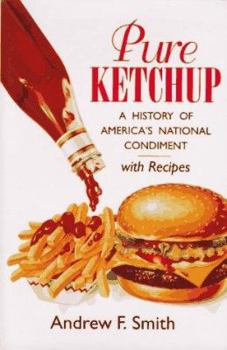Pure Ketchup
Select Format
Select Condition 
Book Overview
For topping French fries or cottage cheese, K rations or school lunches, ketchup has long been an American favorite. In Pure Ketchup, Andrew F. Smith chronicles American milestones in ketchup history,... This description may be from another edition of this product.
Format:Hardcover
Language:English
ISBN:1570031398
ISBN13:9781570031397
Release Date:January 1996
Publisher:University of South Carolina Press
Length:242 Pages
Weight:1.24 lbs.
Dimensions:0.9" x 6.3" x 9.3"
Customer Reviews
2 ratings
Ketchup and history
Published by Thriftbooks.com User , 17 years ago
A good and well researched book with what I needed, a few recipies for non-tomato catchup that I can use to awe my friends in our frequent potlucks. I think grape and walnut katchuip will start my experimentations.
Say, can I get some fries with the ketchup?
Published by Thriftbooks.com User , 21 years ago
According to some arcane device called the Bostwick Consistometer ("Oh, honey, what happened to that old Bostwick we used to have in the attic?"), ketchup "cannot flow faster than fourteen centimeters in thirty seconds at twenty degrees centigrade". Author Andrew Smith, while citing this fact in PURE KETCHUP, fails to say if this is on a downhill slope or level straightaway. I guess I'll have to conduct my own experiments.This book is otherwise a fascinating and fact filled history of the condiment that only an un-American subversive would fail to gobble up with fries. Starting with the origin of the word - "kecap" (Indonesia), "kê-tsiap" (Vietnam?), "escaveche" (France), "iskebêy" (Arab) - Smith describes the evolution of ketchup, or catchup, or catsup, from the old days in Europe, when it was made from everything imaginable (grapes, cucumbers, walnuts, oysters, cherries, mushrooms, apples, apricots, gooseberries, currants, anchovies, cranberries), to the present, when it's a distinctly American food made from tomatoes.In the chapter on the growth of the U.S. ketchup industry in the nineteenth century, the author goes to extreme lengths to name seemingly all the manufacturers of the period and every brand name they marketed. Smith followed the same course in his book on popcorn, POPPED CULTURE. I continue to regard his commendable attention to such detail excessive, but I shan't dwell on it here because I liked PURE KETCHUP more than the other anyway. The best chapter, for me, was the lengthiest one, which describes the bitter battle between pure-food adherents advocating the manufacture of ketchup without preservatives and those espousing the use of such, specifically benzoates. The two camps flailed away at each other for years to the point that even the eventual victor staggered away exhausted. The story of this acrimony might just as well illustrate the course of any debate over food additives or processing, whether it's MSG, aspartame, food irradiation, or the looming conflict over the fat and calorie content of fast foods. As for me, I'm perfectly happy to find the ketchup with the highest content of preservatives, pour it on the biggest order of fries I can buy, and thumb my nose at the Nutrition Gestapo while I chow down.For me, perhaps the major fault of PURE KETCHUP is that it failed to mention, much less define, the place of barbecue and steak sauces in the genealogy of ketchup, if indeed they're related. I was in the supermarket today, and the brands of barbecue sauce far outnumber those of ketchup, and the labels of all I checked included a tomato derivative. So, what about those Andy? (Since Smith and I exchanged friendly emails concerning POPPED CULTURE, perhaps he'll read this and enlighten me.)





